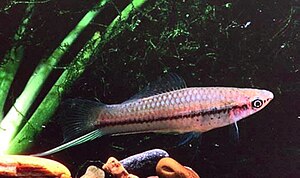Swordtail
| Swordtail | ||||||||||||
|---|---|---|---|---|---|---|---|---|---|---|---|---|

♂, wild form |
||||||||||||
| Systematics | ||||||||||||
|
||||||||||||
| Scientific name | ||||||||||||
| Xiphophorus hellerii | ||||||||||||
| Heckel , 1848 |
The swordtail ( Xiphophorus hellerii ) is in Central America of native fish from the family of livebearing carp , the most popular freshwater aquarium fish belongs.
features
Swordtails have an elongated body with a pointed head. The males have on the lower part of the tail fin a long, straight extension of about a third of the body length, the sword. The coloration varies greatly between different populations. Most color variants have a brown to almost black or red stripe along the middle of the flanks as well as spots on the caudal fin. Above the central stripe, there are one or two more stripes below and above in some populations. The male's sword is bright yellow in color with black edges, the lower one of which is more pronounced. In older specimens, the sword is often completely black.
Captured in the wild are relatively large with males up to 14 cm (without sword) and females even up to 16 cm in length. Cultivated forms are rarely more than 12 cm long (mostly more than 10 cm, early males even significantly more delicate).
Fin formula : dorsal : 11–14, anal 8–10
Occurrence and way of life
The original range of the swordtail stretches from northern Mexico to Guatemala and Honduras . However, it was spread globally by humans, for example in North America to Canada, in Africa and in Australia.
Swordtails prefer fast flowing waters with abundant vegetation. Worms, crustaceans, insects and aquatic plants serve as food.
Reproduction
During mating, an intense courtship can be observed, in which the male with spread fins and full of color dances backwards around the female in large tracks. It then inserts its gonopodium into the female's genital opening and fertilizes it. At the tip of the gonopodium there is a bony hook that prevents the female from escaping (this hook can cause serious damage to alien, crossable females, e.g. platys).
Like all viviparous toothcarps , swordtails also practice mating in which the male inserts his gonopodium into the genital opening of the female to transfer the sperm . The six to nine millimeter tall boys are born after a gestation period of 28 to 42 days. The litters of the wild form consist of 20 to 150 young fish, large females of cultivated forms often give birth to more than 150 offspring in one litter. Aquarium keepers have repeatedly reported an alleged sex change from female to male animals, but these are usually late males . This is how aquarists refer to males of the viviparous toothcarps, which develop their sexual characteristics, especially the gonopodium, late. The physique, apart from the gonopodium, remains female (especially higher back and overall stronger than normal males).
Sex is determined by numerous genes that are not (as in humans, for example) restricted to specific sex chromosomes . In some of the breeding lines examined subsequently, the gender distribution varied from 1: 1 to 1: 4 (in favor of the females). As with related species and genera, the sperm remain functional for months, so that a single copulation is sufficient for several litters.
Individual evidence
- ↑ a b Clyde S. Tamaru & al: A Manual for Commercial Production of the Swordtail. University of Hawaii 2001, Online (PDF; 454 kB).
- ↑ Matthias Trauzettel: Lyraflosser. In: Claus Schaefer, Torsten Schröer (Hrsg.): The large lexicon of aquaristics. 2 volumes, Eugen Ulmer, Stuttgart 2004, ISBN 3-8001-7497-9 , volume 2, p. 608.
- ↑ Dieter Gentzsch, Matthias Trauschein: Xiphophorus […]. In: Claus Schaefer, Torsten Schröer (Hrsg.): The large lexicon of aquaristics. 2 volumes, Ulmer, Stuttgart 2004, ISBN 3-8001-7497-9 , volume 2, pp. 984–992, here: pp. 985 and 987–988.
swell
- Swordtail on Fishbase.org (English)
- JR Paxton: Encyclopedia of the Wildlife: Fish . Orbis Verlag, Munich 2003, ISBN 3-572-01377-1 .
- MK Meyer, L. Wischnath and W. Foerster: Livebearers Zierfische. Kinds of the world . Mergus, Melle 1985, ISBN 3-88244-006-6 .
Web links
- www.zierfischverzeichnis.de
- Video: Parental characteristics in courtship behavior of swordtail hybrids - Xiphophorus helleri, Xiphophorus montezumae . Institute for Scientific Film (IWF) 1975, made available by the Technical Information Library (TIB), doi : 10.3203 / IWF / D-1178 .
- Video: Reproductive behavior of the green swordtail (Xiphophorus helleri) . Institute for Scientific Film (IWF) 1976, made available by the Technical Information Library (TIB), doi : 10.3203 / IWF / D-1179 .

